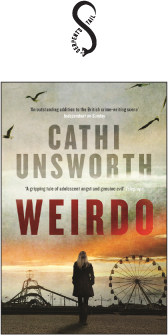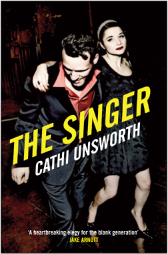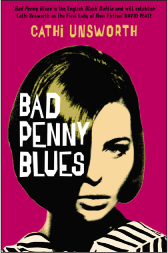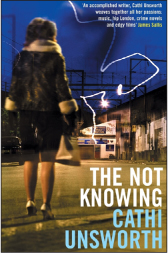Without the Moon (29 page)
Authors: Cathi Unsworth

Working girls â prostitutes.
AUTHOR'S NOTE ON SOURCES AND ACKNOWLEDGEMENTS
The events in this book are based on two real cases which happened within the stated fortnight's timeframe in February 1942: the crimes of Gordon Frederick Cummins, aka “the Blackout Ripper”, and the unsolved murder of Margaret McArthur on Waterloo Bridge, both of which also came to trial within days of each other in the April of that year. Because this is a fictitious account and I have taken liberties with some of the facts and persons involved, not everybody in the book shares the same names as their counterparts did in real life. As in my previous novel,
Bad Penny Blues
, based on the unsolved “Jack the Stripper” murders of 1959â65, I think of this rendering as taking place in a parallel universe.
It was due to the recurring themes of
Bad Penny Blues
that I began to research the crimes of earlier London “Ripper” Cummins; and also the strange case of medium Helen Duncan, the so-called “Blitz Witch”, who was incarcerated under an obscure seventeenth-century law during WWII. The novel I originally envisioned would have taken place over several years. But an unexpected gift narrowed that focus down to two bloody and bizarre weeks in February 1942.
Historian Nick Pelling had been gathering information on the Waterloo Bridge murder with the intent of writing an historical account. However, his efforts to find out what had become of the Canadian Cameron Highlander who was tried and acquitted of the murder of Margaret McArthur at the Old Bailey in April 1942 hit a brick wall and stymied his quest. Having read and approved of
Bad Penny Blues
, thanks to his friendship with my brother, Matthew Unsworth, he generously gave me all he had unearthed in the National Archive and the National Newspaper Archive.
Nick's researches had begun with his fascination with the fact that the second Waterloo Bridge, designed by Gilbert Scott, had been under construction for the duration of the war, an undertaking that seems bewildering in hindsight. But John Rennie's previous Georgian structure had been found to be severely unstable, so London County Council decreed its demolition and the rebuilding of a new bridge in 1937 â and once that was set in motion, they weren't going to let a little thing like the Luftwaffe halt progress. Despite being hit by bombs, the new bridge was completed in March 1942, two weeks after it had been baptised in Margaret McArthur's blood.
Many resonances echoed as I read Nick's notes: the lyrics to the traditional “London Bridge is Falling Down” and their allusion to “my fair lady” that some claim represents a female sacrifice planted beneath the structure to guarantee its continued stability; the tales told to tourists by Thames river boatmen that Waterloo Bridge is known as The Ladies Bridge because a predominantly female workforce built it during WWII. And the haunting, fictional
Waterloo Bridge
, Robert E Sherwood's 1930 play set during WWI that was remade as a film by Mervyn LeRoy in 1940, on a set that resembles Gilbert's bridge, with Vivien Leigh as the tragic, streetwalking heroine who meets her death so close to where the real Margaret McArthur fell.
Like Nick, I became haunted by the question: who was the real Margaret McArthur? Little is revealed in the archives, besides that she was Irish, apparently well educated, and her arrest record for soliciting around pubs on the Strand revealed a taste for poetic noms de plume. Charles Beattie, her common-law husband, did come forward to talk to the police, but his interview indicated she had kept much of her previous life hidden from him, too. I have stuck to the facts that are known about the murder â that Margaret was last seen alive in the Hero of Waterloo pub on the Strand, that a GPO cableman heard a furious argument on the bridge and found a drunken Canadian solider whom he escorted off the site. That the Canadian was then seen by a PC rummaging through a woman's handbag at Waterloo Station and was subsequently picked up in a boarding house in Surrey. Once under arrest, the Canadian requested to see Margaret's body at the post-mortem and then reacted in horror to it; and when acquitted of her murder, he asked for her handbag back. But the backstory I have fashioned for my fictional Margaret is conjured from my own imagination, inspired by stories told to me by my grandmother-in-law, Frances Meekin, of her home in Donegal and work as a midwife during WWII. My further explanations as to why the man tried for Margaret's murder was absolved by the jury, despite the police having what appeared to be a strong case against him (and why it may have been that Nick could not follow his trail any further), also come purely from my imagination.
The sensational case of trainee RAF pilot Gordon Cummins, who savagely despatched four women and attempted to kill at least two more in the week preceding the Waterloo Bridge murder, was successfully solved and the perpetrator hanged by Albert Pierrepoint just prior to an air raid on the given date. I have stuck to the facts of Cummins's murders, including the airman's frenzied last night in Piccadilly and Paddington, but I have altered the names of his victims, their friends and family members, as I have imagined backstories for some of them in lieu of recorded fact.
Simon Read's
In the Dark
(Berkley Books, 2006) is an excellent source of the known facts of the Cummins case, taken again from the National Archive and also from the memoirs of the detectives who caught the Blackout Ripper: Edward Greeno's
War on the Underworld
(Long John Limited, 1960) and Fred Cherrill's
Cherrill of the Yard
(The Popular Book Club, 1955). I also consulted Colin Evans'
The Father of Forensics
(Icon Books, 2007) for background on Sir Bernard Spilsbury, who was also essential in bringing Cummins to justice.
Brilliant men though Cherrill and Spilsbury undoubtedly were, of the three, it was the more wayward Greeno who most fascinated me. Seemingly born on a racecourse, he showed uncommon sympathy for the women killed by Cummins and intuitive understanding of the criminal mind. His memoirs obfuscated his background; I made him into my fictional Ted Greenaway to invent a plausible backstory for an imaginary detective that might help me to better learn the motivations of the man he was based on. The real Greeno did not work on the Margaret McArthur case, though strangely enough, he did bring to justice another murderous Canadian soldier, August Sangret, who killed his girlfriend Pearl Wolfe and buried her body on Hankley Common, Surrey, in October 1942. Greeno's memoir is further interwoven with one of my favourite sources, Charles Raven's
Underworld Nights
(Hulton Press, 1956), often telling what appear to be the same tales from the angle of the criminals Greeno put away. Many of the slang terms used in this novel and its glossary come from these sources.
Donald Thomas'
An Underworld at War
(John Murray, 2003) was the most authoritative and comprehensive book on the subject of criminals, deserters, spivs, racketeers, police, press and civilians in WWII, and how these various factions interconnected.
Few Eggs and No Oranges: The Diaries of Vere Hodgson 1940-45
(Persephone Books, 1999), who worked with Winifred Moyes providing assistance to the bombed-out women and children of the capital throughout WWII, was an invaluable daily account of the madness endured by Londoners, as well as an insight into Miss Moyes and her organisation. Barbara Tate's wonderful
West End Girls
(Orion, 2010) was a similarly illuminating story of the working girls of 1940s Soho.
Malcolm Gaskill's definitive study of Helen Duncan,
Hellish Nell: Last of Britain's Witches
(4th Estate, 2001), provided all the details about the ill-fated medium and led me in turn to the formidable form of Hannen Swaffer, the erstwhile Pope of Fleet Street, to whom no biographer has yet to do justice, least of all his sole representative Tom Driberg, whose
Swaff: The Life and Times of Hannen Swaffer
(Macdonald and Jane's, 1974) did at least provide a chronology. Readers may find it hardest to believe that a committed Spiritualist and ardent socialist was once Britain's most popular journalist, but the celebrated status of this Anti-Richard Littlejohn is by no means made up or exaggerated. Similarly, Swaff 's adversary, Olive Bracewell, is based on the astonishing Violet Van Der Elst, whose campaigns against capital punishment were of the scale described and would eventually rob her of her self-accrued fortune.
The Incredible Mrs Van Der Elst
by Charles Neilson Gattey (Leslie Frewin, 1972) was my source on an audacious life that I have, if anything, toned down for fear of defying credulity. Meanwhile, James Morton and Gerry Packer's
Gangland Bosses
, together with James Morton's
Gangland Soho
, provided further connections between Swaffer and his police and underworld pals.
Julian Maclaren-Ross'
Memoirs of the Forties
, taken from the 2004 Black Spring Press edition of his
Collected Memoirs,
was a peerless time-tunnel trip to the Turkish baths and bohemian Soho. Thanks to Maclaren-Ross' biographer Paul Willetts for bringing those tracts back to life and for the many other kindnesses with research he has shown me during the writing of this book. Similarly wonderful were Joan Wyndham's war diaries
Love Lessons
and
Love is Blue
(Virago 1985, 1986, respectively). Thanks to Max Décharné for putting them my way, as well as many other helpful comments and suggestions, and for a mastermind's knowledge of slang.
Maclaren-Ross' works of fiction, together with those of Patrick Hamilton, Gerald Kersh, Simon Blumenthal, Alexander Baron, Norman Collins, James Curtis, Robert Westerby, Nigel Balchin and Graham Greene, were massive influences and I am grateful to publishers who have kept the least-known of these masters in print, especially John King and Martin Knight of London Books, Robert Hastings of Black Spring Press and Ross Bradshaw of Five Leaves Press, whose editions are presented with such loving care.
Once more, I owe a special debt of thanks to Ruth Bayer for her help on magical matters; and to Emma Murphy for her supernatural gift of the Duchess. The Sohemian Society's Marc Glendening took me on a spooky tour of the Blackout Ripper's haunts that will not be easily forgotten. For lessons in the correct use of London Yiddish, I dunk a beigel to Marc Fireman, and for military manners, I salute Sohemian RSM Dave Fogarty.
As well as all of the above, my thanks and love as always to my family: Phil and Brenda Unsworth, Yvette, William, Tommy and Sophie Rose Unsworth, Cathy Meekin, Danny Meekin, Eva Snee, Danny and Elaine Snee, Mick and Maureen Snee.
More champagne for my real friends: Ann Scanlon, Pete Woodhead, Joe McNally and Dierdre Rusling, Benedict Newbery, Richard and Sarah Newson, Raphael, Lucia and Leo Abraham, Predrag and Damjana Finci, Doreen Montgomery, Fenris Oswin, Dave Knight, Chris Simmons, Paul Murphy, Katja Klier, Meg Davis, Hel, Luke and Adam Cox, Kriss and Lynn Knights, Sal Pittman and Mark Stripling, Mark Pilkington, Syd Moore, Travis Elborough; The Cesarians: Justine Armatage, Charlie Finke, Suzi Owen, Budge McGraw, Bev Crome, Christine Lehlett and Ed Grimshaw; Debbie Voller, Duncan Bolt, Anna Pattenden, Abby Taylor, Margaret Nichols, Claudia Woodward, Lynn, Nick and James Taylor-Haslam, Tom Vague, Ross McFarlane and Phoebe Harkins, David Collard, Lydia Lunch, Jake Arnott, David Peace, Andrew Whitehead, Ken Worpole, Iain Sinclair, Chris Petit, Ronnie Hackston, Anna Whitwham, Julian Ibbotson, Mari Mansfield, Jay Clifton and Vanessa Lawrence, Roger K. Burton and all at the Horse Hospital, James Hollands and Dr Paddy, Billy Chainsaw, Ken and Rachel Hollings, Mike Jay and Louise Burton, Christopher Fowler, Neil and Wenche Perry, Sue Smith, Tony Stewart, Tommy Udo, Damon Wise, Paul Goodhead and the Anthony Newley Society, Greil Marcus, Elizabeth Wilson, Laura Wilson, Dave Collins, Jane Bradley, Michael Dillon and the Gerry's time-tunnel.
Thanks again and triples all round for Anna-Marie Fitzgerald, Niamh Murray, Hannah Westland, Rebecca Gray and all at Serpent's Tail/Profile; François Guerif, Benjamin Guerif, Karine Lalechere, Jeanne Guyon, Hind Boutaljante and all at Rivages.
And a Methuselah of his own for Michael Meekin, the King of Swing.
The best part of going back to the 1940s was the music, due to the genius of the Andrews Sisters, Louis Armstrong, Count Basie, Irving Berlin, Al Bowlly, Bing Crosby, the Cats and the Fiddle, Nat “King” Cole Trio, Tommy Dorsey, Duke Ellington, Ella Fitzgerald, Harry “The Hipster” Gibson, Benny Goodman, Stéphane Grappelli, Henry Hall, Billie Holiday, Leslie “Jiver” Hutchinson, Ken “Snakehips” Johnson, Louis Jordan, Peggy Lee, Glenn Miller, the Mills Brothers, Louis Prima, Django Reinhardt and Fats Waller. Special thanks also to Jerry, Jan and Jocelyn at the Pink Shop for the Black British Jive compilation and for telling me the tragic true story of Snakehips Johnson, which I couldn't help but weave a little of into this tale.
The films
It Always Rains on Sunday
(Robert Hamer, 1947),
They Made Me a Fugitive
(Alberto Cavalcanti, 1947) and
Waterloo Bridge
(Mervyn LeRoy, 1940) helped evoke a lost London. Karen Livesey's 2006 documentary
The Ladies Bridge
offered an intriguing glimpse into the history of the construction of Waterloo Bridge and the story of The Ladies Bridge.
Finally, to the memory of Charlotte Greig, Dave Jennings and Ronnie Rocka, who left too soon but will not be forgotten.
ALSO BY CATHI UNSWORTH

Weirdo
ISBN 978 1 84668 793 8
eISBN 978 1 84765 849 4

The Singer
ISBN 978 1 84668 640 5
eISBN 978 1 84765 472 4

Bad Penny Blues
ISBN 978 1 84668 678 8
eISBN 978 1 84765 269 0

The Not Knowing
ISBN 978 1 85242 892 1
eISBN 978 1 84765 595 0
